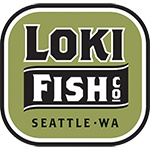They come out of the water perfect. We just try not to screw it up! -Pete Knutson

Pink Salmon
Latin Name: Oncorhynchus gorbuscha
Other common name: Humpies
Pink salmon are the most abundant, as well as the smallest species of Pacific Salmon, averaging 3-5 pounds. They also have the shortest life-span of just two years. Pinks run every other year (odd numbered years in the Pacific Northwest, even numbered years in most parts of Alaska). In Southeast Alaska where we fish, intersecting runs means that we have the opportunity to harvest Pink salmon every summer.
Pinks are by far the most underrated and misunderstood salmon species. Their small size and plankton-based diet mean that they have fragile flesh that must be handled properly when caught in order to reach market in suitable shape. Unfortunately, most Pinks are handled poorly out of the water, sucked through a vacuum tube onto processing boats and end up being industrially canned. Firmer flesh salmon such as Sockeye can withstand more of this abuse, but under this type of stress the Pinks don't fare nearly as well. For this reason, Pinks have gained a reputation as being mushy, low quality salmon. A properly handled Pink is a different animal altogether; with a mild flavor and a tender, delicate flake, Pinks are a staple source of protein for many of our customers.
While none of the salmon species that we harvest have issues with toxin levels, due to their short life-cycle and eating low on the food chain, Pink salmon are the cleanest of all the salmon species in terms of bio-accumulation of toxins.

Keta Salmon
Latin name: Oncorhynchus keta
Other common name: Chum
Keta salmon are the second most abundant species of salmon, averaging 10-15 pounds. They spend a short amount of time as fry in the estuaries before heading out to the ocean to mature. They have an average life span of 3 to 6 years. We fish for Keta salmon in Southeast Alaska in the summer, and the greater Puget Sound area in the fall.
Keta have gotten a bad rap over the years. The main reason for this is that due to eating lower on the food chain, their flesh rapidly begins to turn pale as they enter fresh water environments to spawn. These fish are still more than suitable for smoking and jerky, but as a fillet product are not as visually appealing. We high-grade all of the Keta salmon that we harvest into #1's (fillet quality), #2's (for smoking), and #3's (for jerky). Keta has a fairly mild flavor, and a thick flake size. This makes it popular for marinades or special seasonings, as the fish will soak up whatever you flavor it with.

Coho Salmon
Latin name: Oncorhynchus kisutch
Other common name: Silver
Coho salmon average 7-11 pounds. They spend one to two years in freshwater stream environments before migrating to the ocean to fully mature. They have an average life span of 2 to 4 years. We fish for Coho salmon in Southeast Alaska in the summer.
Coho salmon are a favorite of those looking for a savory, flavorful salmon that is not overpowering. Coho have an ample amount of oil and fat in their flesh, but are not as strong tasting as Sockeye or King. Coho is best enjoyed filleted or smoked.

Sockeye Salmon
Latin name: Oncorhynchus nerka
Other common name: Red
Sockeye salmon average 3-8 pounds. They spend up to three years in freshwater lake environments before heading out to the ocean to fully mature. They have an average life span of 4 to 6 years. We fish for Sockeye salmon in Southeast Alaska in the summer.
Sockeye have the reddest, densest flesh of all the salmon species. This is due to their diet, which is composed primarily of krill. For this reason, Sockeye is a prized salmon and fetches a premium price. Although Sockeye handle the abuses of industrial fishing better than some of the other species, it is common to see Sockeye fillets in supermarkets that look "tired". This is usually due to heat-stress and improper refrigeration of the salmon at the time of harvest. A well-handled Sockeye should be firm, with bright, translucent eyes and no soft spots or gashes. Sockeye is best enjoyed filleted, smoked or canned.

King Salmon
Latin name: Oncorhynchus tshawytscha
Other common name: Chinook
King salmon are the largest of all Pacific Salmon, averaging 10 to 50 pounds. They spend one to two years in freshwater river environments before heading out to the ocean to fully mature. They have an average life span of 5 years. We fish for King salmon in Southeast Alaska in the summer.
King salmon have the oiliest, thickest flesh of all the salmon species. This is due to their large size and highly carnivorous diet. They are a prized fish both for filleting and smoking, and command a premium price. Kings make up a very small percentage of all the salmon we harvest in a normal year. Normally we sell all of our King's fresh at the farmers markets in the summer, and have just a small amount of smoked and frozen that sells out quickly in the fall.
Salmon illustrations courtesy of Alaska Seafood Marketing Institute.





